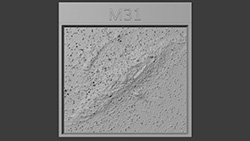CXC Home | Search | Help | Image Use Policy | Latest Images | Privacy | Accessibility | Glossary | Q&A
1
X-ray, Optical, and Radio Images of the Andromeda Galaxy, M31Credit: X-ray: NASA/CXO/UMass/Z. Li & Q.D. Wang, ESA/XMM-Newton; Infrared: NASA/JPL-Caltech/WISE, Spitzer, NASA/JPL-Caltech/K. Gordon (U. Az), ESA/Herschel, ESA/Planck, NASA/IRAS, NASA/COBE; Radio: NSF/GBT/WSRT/IRAM/C. Clark (STScI); Ultraviolet: NASA/JPL-Caltech/GALEX; Optical: Andromeda, Unexpected © Marcel Drechsler, Xavier Strottner, Yann Sainty & J. Sahner, T. Kottary. Composite image processing: L. Frattare, K. Arcand, J.Major
Astronomers study Andromeda (Messier 31, or M31) to understand the structure and evolution of our own spiral galaxy, the Milky Way. This new composite image contains data of M31 includes X-rays from Chandra and XMM-Newton, ultraviolet data from GALEX, optical data from astrophotographers using ground-based telescopes, infrared data from Spitzer, IRAS, COBE, Planck and Herschel, and radio data from the Westerbork Synthesis Radio Telescope. Each type of light reveals new information about this close galactic relative to the Milky Way.
2
3D Printable Files: Andromeda Galaxy, M31(3D Print Credit: NASA/CXC/A. Jubett, using software by Tactile Universe/N. Bonne & C. Krawczyk & Blender)
This tactile plate is a physical relief map based on the intensity of Chandra X-ray data along with radio, infrared, optical and ultraviolet data, featuring the Andromeda galaxy, our closest spiral galaxy neighbor. The multiwavelength data helps astronomers understand the evolution of the Milky Way, our own spiral galaxy, and provides a fascinating insight into astronomical data gathering and presentation.
Like all spiral galaxies observed at this distance and angle, Andromeda appears relatively flat. Its spiraling arms circle around a raised core, creating a bulging disk shape, like a large dinner plate. Andromeda’s flat surface is tilted to face our upper left.
This plate features data from some of the world’s most powerful telescopes, each capturing light in a different spectrum. In each single-spectrum wavelength, Andromeda has a similar shape and orientation, but the details are dramatically different.
In radio waves, the spiraling arms present like a loosely coiled rope. The center features no discernible radio core. In infrared light, the outer arms are similarly protruding. But here, a spiraling ring encircles a puffy center with a small infrared core. The optical data is hazy, with spiraling arms like faint smoke rings. Here, the vastness of space is dotted with points of light, and a small dot contributes to the multiwavelength bump of the core of the galaxy. In ultraviolet light the spiraling arms are also evident, with a ball at the core. No spiral arms are present in the X-ray data, which is most concentrated at the core.
Like all spiral galaxies observed at this distance and angle, Andromeda appears relatively flat. Its spiraling arms circle around a raised core, creating a bulging disk shape, like a large dinner plate. Andromeda’s flat surface is tilted to face our upper left.
This plate features data from some of the world’s most powerful telescopes, each capturing light in a different spectrum. In each single-spectrum wavelength, Andromeda has a similar shape and orientation, but the details are dramatically different.
In radio waves, the spiraling arms present like a loosely coiled rope. The center features no discernible radio core. In infrared light, the outer arms are similarly protruding. But here, a spiraling ring encircles a puffy center with a small infrared core. The optical data is hazy, with spiraling arms like faint smoke rings. Here, the vastness of space is dotted with points of light, and a small dot contributes to the multiwavelength bump of the core of the galaxy. In ultraviolet light the spiraling arms are also evident, with a ball at the core. No spiral arms are present in the X-ray data, which is most concentrated at the core.
Return to: NASA's Chandra Shares a New View of Our Galactic Neighbor (June 25, 2025)










